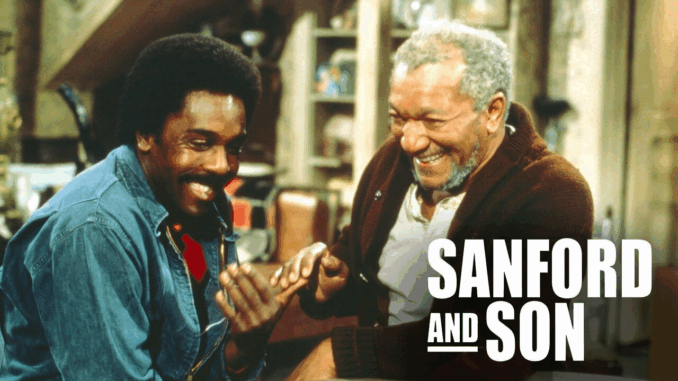
When Sanford and Son premiered on January 14, 1972, it was a thunderbolt to the television landscape. With its all-Black main cast, its raw, unfiltered humor, and its unflinching look at a working-class family, the show was a revolutionary force. For five decades, it has remained a staple of American pop culture, but its legacy is a complex one. As we look back 50 years after its debut, it’s clear that Sanford and Son was a “double-edged” pioneer—a show that broke down barriers and paved the way for future Black sitcoms while also, at times, relying on the very stereotypes it was supposed to subvert.
The show, a collaboration between legendary comedian Redd Foxx and television producer Norman Lear, was an adaptation of the British sitcom Steptoe and Son. In the American version, it followed the daily antics of Fred G. Sanford, a crotchety junk dealer, and his long-suffering son, Lamont. Their hilarious and often heartfelt arguments, punctuated by Fred’s signature fake heart attacks, created a comedic dynamic that was both authentic and groundbreaking for its time.
The Revolutionary Breakthrough
The brilliance of Sanford and Son cannot be overstated. Before its premiere, television had seen a handful of shows with Black leads, but they were often defined by their whiteness. Shows like Julia, which depicted a middle-class nurse and a widowed mother, were praised for their positive representation but were also criticized for sanitizing the Black experience. Sanford and Son was a radical departure.
For the first time on a mainstream network, audiences were introduced to a Black family that was not wealthy, not a picture of perfection, but was, in fact, a real, working-class family living in a modest home in Watts, Los Angeles. The show’s humor was rooted in their daily struggles, their relationships, and the idiosyncrasies of their life. It was a sitcom that was authentically Black, filled with inside jokes, cultural references, and a raw, comedic energy that had never been seen on network television before.
The dynamic between Redd Foxx as Fred and Demond Wilson as Lamont was the show’s secret weapon. Their on-screen chemistry was electric. Foxx, a veteran of the stand-up comedy world, brought a wild, improvisational energy to the role, while Wilson, a more classically trained actor, provided a sense of grounded realism. Their banter felt real and their love for each other, despite their constant bickering, was palpable. This dynamic was a reflection of the love and conflict that exists in every real-life family, and it resonated deeply with audiences of all backgrounds.
The Double-Edged Legacy
Despite its groundbreaking nature, Sanford and Son was not without its critics. Even during its initial run, and especially in the years since, scholars and fans have debated the show’s use of stereotypes. The core of the criticism centered on the fact that Fred Sanford was often portrayed as a lazy, ignorant, and cantankerous old man, a caricature that, for some, felt like a regression to minstrel-like stereotypes.
Fred’s constant feuds with his “Big dummy” son, his fear of his sister-in-law “Aunt Esther,” and his reliance on a fake heart attack as a punchline were all fodder for immense laughter. But for some, this humor was a double-edged sword. While it provided an entry point for a more authentic type of Black comedy, it also risked reinforcing negative portrayals of Black masculinity and family life. The show was produced by Norman Lear, a white creator, which also raised questions about the authenticity of the show’s voice and whether the humor was always on its own terms.
The series also faced criticism for its lack of strong, multi-dimensional female characters. The women in Fred’s life—Aunt Esther and his girlfriend Donna—were often reduced to one-note characters: the fire-and-brimstone matriarch and the long-suffering love interest. While characters like Thelma and Willona on Good Times and Florida and Maude on Lear’s other shows were given full, complex lives, the women of Sanford and Son were largely there to serve as a foil to the men’s antics.
The Enduring Impact
Despite its flaws, Sanford and Son‘s impact on television history is undeniable. Its success proved that a show with a primarily Black cast could be a ratings juggernaut. It paved the way for other iconic sitcoms of the 1970s, including Lear’s other shows like The Jeffersons and Good Times, which were also unafraid to tackle social issues and portray Black families with a new level of complexity.
Sanford and Son showed that Black life could be the source of rich, universal comedy. The show’s themes of family, love, and the struggles of the working class were relatable to everyone, regardless of their background. It taught Hollywood that authenticity, even if it was at times flawed, was a powerful tool for storytelling.
The show’s legacy continues to this day. Its influence can be seen in modern comedies, and its reruns remain popular with new generations of viewers. The debate over its use of stereotypes is a testament to its cultural significance. It is a show that is both celebrated for its breakthroughs and critiqued for its blind spots—a dual legacy that makes it all the more important to study and understand.
Fifty years later, Sanford and Son stands as a landmark in television history. It was a show that was unafraid to be loud, messy, and unapologetically funny. Its laughter was rooted in a reality that many Americans had never seen on television before, and in doing so, it changed the game forever. Its double-edged legacy is not a stain but a mark of its authenticity, a reminder that progress is often complicated, but always worth the effort.
